In Short: To get your company featured on Forbes in 2026, you need a newsworthy angle, tailored outreach, and – ideally – relationships with Forbes contributors. Expect to spend 20 to 50 hours doing research and pitching, or $3,000–$10,000 via agencies. Below you’ll find step-by-step outreach templates, email-finding tools, pricing data, and proven strategies we use successfully for clients today.
–––––––––––––––––––––––––––––––––––––––––––––––––––––––––––––––––––––––––––––––––––––––
How can I get featured on Forbes? – Whenever I explain my occupation during a friendly get-together, this always one of the first questions to be asked.
With north of 150 million monthly readers and a remarkable reputation that is based on a history of more than a century, Forbes is widely considered the holy grail of business media. As a result, every entrepreneur and their mother hope to be featured, or even simply mentioned, in a Forbes article at one point in their career.
In the past few years, my partner and I have helped hundreds of clients – including solo entrepreneurs, startups, huge corporations, and NGOs – to get featured on the world’s most popular business publication: Forbes.
In this guide, we will walk you through every step needed, and all the strategies we’re using today so that you can make it too. So, make yourself comfortable and put on your glasses; this is going to be a long one.
What are the benefits of an article on Forbes?
Before we get to the hard stuff, let’s first recapitulate why you should want to get a Forbes feature in the first place. Even if you already see a lot of value in such a placement, it still makes sense to know all the benefits that arise with an article on your business, especially when it comes to leveraging a successful placement properly.
Let’s dive right in.
1. Reputation & brand awareness
Reputation management is often among the key selling points for public relations services. Thanks to globalization and popular culture, almost every person on earth seems to have heard of the prestigious Forbes Magazine at some point in their lives.

Furthermore, many business people seem to associate the brand with big corporations, billionaires, and serious business. Therefore, a company portrait or even a small feature can greatly impact your perceived value.
2. Potential sales
We would be lying if we said that every placement on Forbes or other high-profile sites will undoubtedly boost your sales. While it is true that a good reputation often leads to increased revenue, the truth is that a small mention most probably isn’t going to make a massive difference to your sales.
In fact, with tens of thousands of articles going live on the internet every single day, only the most viral ones are can guarantee a big amount of sales.
That said, we did have many clients that saw huge spikes in sales after their product or company was spotlighted in a Forbes article. Especially in the premium sector, the potential can be significant.
Typically, these successes come in the form of list articles or product and service reviews. Thus, when it comes to driving sales, it very much depends on the specific way your business is reported on.
3. New opportunities
Due to its enormous popularity among business folks, Forbes is a daily read for many important decision-makers, such as C-level executives, investors, entrepreneurs, influencers, and more. This group of people is usually challenging to reach via traditional advertising.
Consequently, being presented to this clientele by a reputable media outlet is much more likely to grab their attention. In fact, dozens of our clients reported that their placement has helped establish price-less connections and long-lasting partnerships.
For instance, if your goal is to become a sought-after speaker at business events, a feature on Forbes can certainly help to convince the right people.
How much does it cost to get featured on Forbes?
This is another question that we get asked very frequently. The short answer is nothing. Yes, you read it right. If you get lucky, there are absolutely no costs associated with a Forbes placement.
The long answer is that you most likely have to decide between investing a lot of time or a decent amount of money on your own Forbes story.
How much that is highly depends on variables such as your niche, your brand reputation (including personal brand), the date, and, of course, a little bit of luck. Here are four different approaches and the price tags that come along with them.
1. Solo
Even without existing knowledge about media relations, it is entirely possible to achieve a spotlight on Forbes on your own. Depending on your situation and strategy, though, you might need to put in serious hours, especially when choosing to work without a budget.
Media research, list building, nurturing relationships, and sending out pitches can not only take dozens of hours to perform but also last for several months until you finally succeed.
Therefore, it seems wise to at least invest in some reasonably priced tools, as we will explain in this guide later.
2. In-house team or freelancers
If you already have a lot on your plate, you might want to consider hiring a freelancer or employee to take care of your media relations. However, while this approach will save you a considerable amount of time, you need to be wary when selecting the right person for this job.
After all, you want to make sure that your company is painted in a positive light. When it comes to such important aspects, cutting corners is usually not the best decision.

Moreover, you should bear in mind that your freelancer or employee might not succeed even with the right strategy, leaving you with high costs yet without results.
3. PR agency
A public relations agency is often the go-to source for features on big mainstream media like Forbes. Since a PR agency ideally employs genuine professionals, they can usually deliver a nice feature in only a few weeks.
Nevertheless, the swift and reliable service also comes with a hefty price tag, as many agencies charge as much as $15,000 for a single feature, and usually around $5,000 for a brand mention as of 2026.
In addition, most PR agencies demand an upfront retainer, which is charged to ensure a long-term commitment between the client and the agency.
4. getonforbes.com
Those looking to get a Forbes feature without engaging in a long-term collaboration with an expensive agency might find another alternative solution in our in-house Direct Feature Service.
Just like a PR agency, we are able to deliver Forbes.com placements in a timely manner and according to your needs. Furthermore, we strive to offer reasonable rates and won’t ask you to sign any long-term contracts. For more information, head over to our services page.
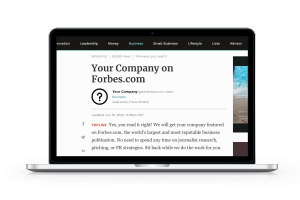
How to get a reporter to write an article for you on Forbes?
So, we finally arrived at the point where things get interesting. As promised, you will learn precisely how we’re doing it. We will now look into three different approaches and explain how they work and what you can do to improve your chances.
On a side note, if your goal is to get on Forbes as fast as possible, you are advised to employ all of the three strategies at the same time.
1. Email outreach
From our experience, traditional email outreach is still the most effective way to get featured on Forbes. Everyone has an email, everyone reads his emails, and everyone can be convinced to write about something via emails. Well, at least almost everyone.
Besides, the email approach has the highest chance of yielding you a full feature spotlight article. Here’s how you do it:
In the first step, you have to determine the niche(s) your business is focusing on, and what it stands for. This can be something as vague as “technology,” but also a little more precise, like “learning software.”
It pays to be diligent in this step. Determine as many angles as possible, as this will significantly increase your chance to be successful.
If you’re satisfied with your research, it is time to find the right authors for your business. Your greatest weapon for this is Google.
Just google a few topics related to your niche(s) and add “Forbes.com” to the search query. Now click on as many articles as possible and note down the authors that wrote the pieces, including their writing beats, short-bio, and ideally social media accounts.

Once you completed your initial list, it is time to collect the emails for each writer. How you can get the emails of Forbes journalists and contributors will be explained later in this guide. You most likely won’t be able to get an email for every writer you selected, but you will indeed find quite a few.
With the emails collected, we recommend checking out the social media profiles of the remaining reporters and accumulate some data about them, e.g., how they click, what they like, and, most importantly, what they don’t like. You will need this information when preparing pitches.
You’re almost done with the preparations to get featured on Forbes. Before sending out emails, the final step is to sit down and craft personal and outstanding pitches with the information you have. You will learn how to write a pitch for Forbes in the last section of this article.
You can repeat this process regularly and even pitch to the same journalists after a certain time has passed (think once a month). Just make sure that you’re coming up with new angles and not forcing the same old story on them again and again.
Note: you can find tried and true templates for PR email outreach at the bottom of this article.
2. Social media outreach
Reaching out to reporters on social media is, in many ways, similar to email outreach. A key advantage of social media chats is that they can become much more personal and down-to-earth than an email conversation. This can significantly increase your chances of succeeding.
Still, be aware that social media outreach usually requires you to build solid relationships before pitching a story, since Forbes reporters are typically flooded with article suggestions all the time.
To get started, make sure that you completed the first two steps of the email outreach approach. Once you have a decent list of writers in your niche, it is time to “stalk” them on social media.
The easiest way to connect with reporters nowadays is LinkedIn. People tend to be quite open on LinkedIn and are also fairly easy to reach. Start by sending a request to connect and mention that you’re a frequent reader of their articles.
If you’re a charismatic person, you most likely won’t have any issues with building rapport.
You can choose to pitch your story directly, but we wouldn’t recommend it with all the spam that is going on – unless your angle is truly timely AND newsworthy. Instead, actually read their articles and occasionally suggest a few ideas to write about that are not directly related to your company.
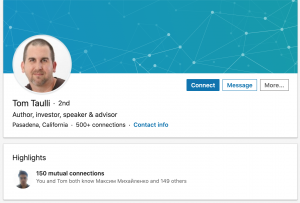
When you have had a good conversation going for a few weeks, you can start feeding them with (ideally exclusive) newsworthy bits about your company. Make sure never to be disrespectful or asking for too much, as it could erase your chances in a heartbeat.
In our experience, starting a conversation with a reporter has a much higher success rate than via email. On average, around 50% of reporters accept our requests to connect, while less than 20% of reporters actually respond to emails.
Twitter is another social network that many Forbes writers use very actively. Twitter is often an excellent platform to connect with the more famous authors, which have a large following and barely respond to emails and LinkedIn requests.
Whatever strategy you may pursue, it is always a good idea to follow journalists on Twitter. First of all, this allows you to keep track of what your target authors are currently writing about, which sometimes even leads to direct opportunities. Secondly, actively reacting to their posts puts your name on the map.
No matter if you’re pitching via Email, Linkedin, or Twitter, they will have heard your name before, which can definitely further increase your chances.
When it comes to pitching your product or company, Twitter also has a significant downside. Since private messages are often hard to send on Twitter, we’re using it only if all other options are exhausted for a specific writer.
3. HARO (Help A Reporter Out)
Finally, let’s head over to a less-known strategy. In fact, it is also the one with the least amount of time you need to invest. Its name is HARO.
HARO, or Help A Reporter Out, is a free service provided by the PR-software behemoth Cision. In a nutshell, HARO allows journalists from all industries to connect with experts and PR folks.
This means that journalists can post specific requests on the HARO platform, whereas experts and PR pros receive those requests via email three times per working day. Although your pitches won’t be accepted every time, we’ve been using this service for years with great success.
Once you’re registered as an expert, all you have to do is reading the requests when they come out and answer where you see a fit. We’d highly recommend writing your answers as detailed as possible unless requested otherwise. Fortunately, many Forbes writers covering all kinds of industries use HARO on a regular basis.
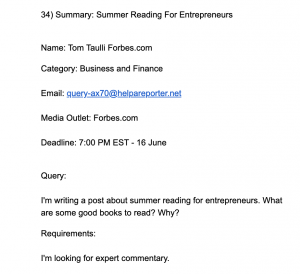
Of course, this service has its own limitations. While it may not take a lot of time to check journalist requests a few times a day, it is rather rare that your company is the perfect fit for a Forbes reporter request, depending on your industry.
Most of the time you have to try your luck with requests that are only remotely related to your business. Furthermore, even if a reporter accepts your answer, you will most likely only get a small brand mention.
That being said, we still think that HARO is a great tool to get featured on Forbes. Remember, even a tiny brand mention can help you land a full story in the future.
How to get Forbes reporter email addresses?
After you completed your first step, you should know which writers you want to contact. If you’re following the email approach, the next step is to determine where you can send your emails so that the right people are actually reading them.
Thus, it’s time for email research.
1. Manual search
If you’re operating on a tight budget, manual search is the way to go. Sometimes you get lucky, and the email is directly displayed on a Forbes profile. Most of the time, however, you’re going to have to do some digging to find the right email.
Besides checking social media profiles, we found that an efficient way to discover email addresses is to simply google a Reporter’s name and the word “email.” In some cases, the journalist has a public email on his personal website or an open platform.
By including the word “email” in your search, you will quickly recognize if that is the case. If you don’t find something in the first run, be sure to try out different variations, such as “email,” “@,” as well as with and without quotation marks.
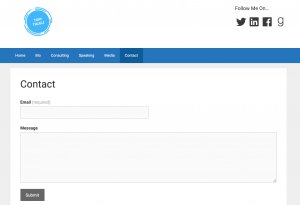
It’s also possible to simply guess emails. You don’t even need to be a mentalist to do so. Simply try out common combinations such as firstname.lastname@domain.com and you might get lucky.
Another option would be to simply contact reporters via social media and ask for their email.
Obviously, this strategy is relatively time-consuming and not always leads to success, as many reporters simply don’t have a public email.
2. Rocket Reach
Rocket Reach is a vast email database where users can look up emails from all kinds of people, including celebrities, CEOs, and journalists. For $55, you can unlock up to 125 emails, which should be more than sufficient for this task.

While it does sound great at first, Rocket Reach still lacks email addresses of quite a few reporters. We found that the service is able to provide emails of roughly 65 percent of all writers on Forbes.
3. Media databases
The most time-efficient yet costly method represents large media databases like Cision, MuckRack, or Meltwater. These databases not only contain almost every single reporter email that exists, but they also provide further information like you would manually collect in the first step of this guide.
Every PR agency uses one or more of these databases, as they are highly efficient, reliable, and updated regularly.

While media databases are a great tool to save time, they also charge quite a lot for their service. Cision, one of the largest providers in the space, charges a whopping $10,000 per annual subscription – and that’s just their entry level pricing. Muckrack charges $5,000 for a one-user license annually.
More affordable, but less comprehensive platforms – such as Prezly or JournoLink – may ask for anything from $2000 to $3,500 per year.
4. Forbes Writer Profiles by getonforbes.com
Since none of the options above seem to be the perfect solution, we decided to create it by ourselves.
In our Forbes Writer Profiles series, we offer you access to an exclusive database that not only includes more than 250 emails of Forbes journalists, but that also features valuable data to use for your pitches.
A writer profile typically includes aspects such as writing beats, personal preferences, social media activity, and more. That way, you will save a significant amount of time that is usually needed to complete the first two steps, at a drastically lower price point than a traditional media database.
If you’re interested in our Forbes Writer Profiles, you can find out more here.
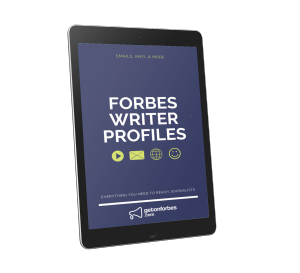
How to pitch an idea to Forbes journalists?
You did your writer research and collected all the email addresses you need. Going into detail in this article would almost turn it into a book, which is why we also wrote a detailed guide for writing a marvelous pitch.
If you don’t feel like reading another in-depth article, at least check out these bullet points:
1. Make it personalized
The reason why we recommend collecting all those data about the authors is to create personalized pitches, that perfectly fit each reporter.
2. Provide newsworthy facts & figures
If available, you want to include solid data in your pitches. This could be metrics such as user growth, but also big partnerships, revolutionary products, and others. It’s vital to make sure that your facts are actually newsworthy.
3. Don’t exaggerate
Don’t claim that you’re the best in something when you can’t back it up with hard facts. Of course, you want to present yourself and your business from the best viewpoint, but always remember to stay humble.
4. Offer precious insights
Even if you’re company is just doing boring stuff that usually no one would care about, you can still leverage your experience and knowledge about a particular niche. In fact, offering valuable insights is often more appreciated than anything else by journalists.
5. Use our templates
If you’re new to public relations and are still unsure about how to best structure a pitch, then why don’t you make use of our curated Forbes pitching templates, which have been updated for the 2026 media landscape.
Below you will find templates to pitch your business to Forbes reporters via Email and on LinkedIn. All of these are based on pitches that have actually been successful in getting our clients included in Forbes articles.
Breaking news template
This pitching template should be used for breaking news only – e.g., partnership, product, financial, ESG announcements or similar.
The goal is to cover the 5 Ws (what, when, where, who, why) in 80-150 words. Every sentence counts; focus on facts and statistics. Offer access to a press release or interview for more information.
Click here to use our template.
Thoughtleadership template (e.g. commentaries)
This template should only be used when pitching an entrepreneur or executive as an industry expert for thought leadership opportunities. This includes providing commentary or interviews on timely topics.
For the best success, search for hotly debated topics in your industry (e.g. recent policy changes, events, controversial figures, etc.) and position yourself as an expert on these matters.
Click here to use our template.


